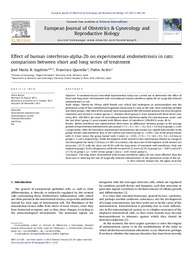Por favor, use este identificador para citar o enlazar este ítem:
https://hdl.handle.net/11000/30944Registro completo de metadatos
| Campo DC | Valor | Lengua/Idioma |
|---|---|---|
| dc.contributor.author | Rodríguez Ingelmo, José María | - |
| dc.contributor.author | Quereda Seguí, Francisco José | - |
| dc.contributor.author | Acién, Pedro | - |
| dc.contributor.other | Departamentos de la UMH::Salud Pública, Historia de la Ciencia y Ginecología | es_ES |
| dc.date.accessioned | 2024-02-01T13:58:56Z | - |
| dc.date.available | 2024-02-01T13:58:56Z | - |
| dc.date.created | 2013-04 | - |
| dc.identifier.citation | European Journal of Obstetrics & Gynecology and Reproductive Biology Supports open acces Volume 167, Issue 2, April 2013, Pages 190-193 | es_ES |
| dc.identifier.issn | 0301-2115 | - |
| dc.identifier.issn | 1872-7654 | - |
| dc.identifier.uri | https://hdl.handle.net/11000/30944 | - |
| dc.description.abstract | Objective: A randomised and controlled experimental study was carried out to determine the effect of short and long series of treatment with recombinant human interferon-alpha-2b on surgically induced endometriosis in rats. Study design: Ninety-six Wistar adult female rats, which had undergone an autotransplant into the peritoneal cavity of four endometrial fragments measuring 4.5 mm at the side, were randomly divided into three groups. One third of the animals were manipulated like the treated animals but were not given treatment and served as control (group C). Another third (group S) were treated with three doses (one every 48 h, 100,000 U per dose) of recombinant human interferon-alpha-2b (subcutaneous route), and the last third (group L) were treated with fifteen doses of interferon (100,000 U every 48 h). Results: Before interferon was administered, there were no differences between groups in the average growth of experimental endometriosis per animal (17.3 6.7, 18.1 9.2, 16.4 5.6 mm in groups C, S and L respectively). After the treatment, experimental endometriosis per animal was significantly smaller in the groups treated with interferon than in the control non-treated group (p < 0.001), and in the group treated with 15 doses versus the group treated with 3 doses (p < 0.05), (17.6 7.5, 14.0 9.5, 9.4 6.0 mm in groups C, S, and L respectively). While the implants of the animals in the control group showed no change in size throughout the study (120 days) (+1.96% of variation), the mean size of the implants in the treated rats decreased, (22.7% with the short and 42.8% with the long series of treatment with interferon). Only one implant in group C (0.8%) disappeared, while this occurred in 27 cases (22.5%) in group S (p < 0.001) and in 45 (37.5%) in group L (p < 0.001 versus group C and p < 0.05 versus group S). Conclusion: The long series of treatment with human interferon-alpha-2b was more effective than the short one in reducing the size of surgically induced endometriosis in the peritoneal cavity of the rat. | es_ES |
| dc.format | application/pdf | es_ES |
| dc.format.extent | 4 | es_ES |
| dc.language.iso | eng | es_ES |
| dc.publisher | Elsevier [Commercial Publisher] | es_ES |
| dc.rights | info:eu-repo/semantics/openAccess | es_ES |
| dc.rights.uri | http://creativecommons.org/licenses/by-nc-nd/4.0/ | * |
| dc.subject | Experimental endometriosis | es_ES |
| dc.subject | Immunological system | es_ES |
| dc.subject | Immunomodulation | es_ES |
| dc.subject | Interferon | es_ES |
| dc.subject | Rat | es_ES |
| dc.title | Effect of human interferon-alpha-2b on experimental endometriosis in rats: comparison between short and long series of treatment | es_ES |
| dc.type | info:eu-repo/semantics/article | es_ES |
| dc.relation.publisherversion | https://doi.org/10.1016/j.ejogrb.2012.11.019 | es_ES |

Ver/Abrir:
Effect of human interferon-alpha-2b on experimental endometriosis in rats.pdf
212,33 kB
Adobe PDF
Compartir:
 La licencia se describe como: Atribución-NonComercial-NoDerivada 4.0 Internacional.
La licencia se describe como: Atribución-NonComercial-NoDerivada 4.0 Internacional.
.png)